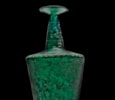Green Cut Glass Bottle
From the 9th Century, Islamic artists revived the skills and techniques of glassmaking which had sadly been lost after the demise of the Roman empire. Many methods including the millefiori technique, overlay glass, sandwich glass, luster and enamel decoration and various kinds of cutting and engraving techniques were rediscovered and mastered. This bottle is demonstraits the incredible knowledge and skill of the maker in every aspect. The form is clean and pure, with high sides, elegent long tapered neck and flared lip. The cut decoration is intricate well placed. However the crowning glory of this wonderful piece is its rich jewel-tone green colour.
Previously in the Private Collection of Mr Wladimir Rosenbaum (1894-1984), Ascona, Switzerland, who acquired this object at some point between 1972-1975 from an art gallery.
Subsequently inherited to his wife Sybille Rosenbaum-Kroeber (1915-1997) in 1984.
Thence by descent to her son Bernd Kroeber in 1997, Hesse, Germany.
Wladimir Rosenbaum (1894-1984) was born in Lithuania of Jewish Russian descent, he was brought to Switzerland as a child in 1902 by his Father to avoid the anti-Jewish pogroms in the Russian Empire. Like his father, he became a respected lawyer, as well as an antiquarian and art dealer.
He was naturalized in Zurich and married concert pianist Aline Valangin in 1917. He and Aline ran a gallery in Zurich, where they kept close ties to the artistic avant-garde, including Hans Arp and Max Ernst, Ignazio Silone and Ernst Toller, Elias Canetti, Thomas Mann, Hermann Hesse and Martin Buber.
He was also close with psychoanalyst CG Jung and various founding members of Dadaism. This was all whilst maintaining a successful career as a defence lawyer, committed to fight against national socialism and anti-Semitism.
In 1929, he and his wife acquired Casa Barca in Comologno in the Onsernone Valley, which became a meeting place for persecuted artists. Including Kurt Tucholsky, Max Bill, Meret Oppenheim and Max Ernst.
In 1937, Rosenbaum was arrested for his close connection to the lawfirm which had become embroiled with disputed arms transactions in the Spanish Civil War, causing him to lose his license to practise law. In 1938, the federal court sentenced him to four months in prison.
After his release, he and his wife moved to Ascona, where he lived until 1984 as an antiquarian and art dealer in ‘Casa Serodine’. He later married for the second time to the Swiss photographer and writer, Anne de Valenti-Montet (1912-2009), and for the third time in 1957 to librarian and actress Sybille Kroeber (1915-1997).










 Enquire
Enquire




